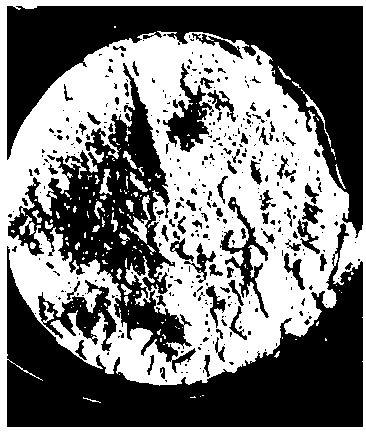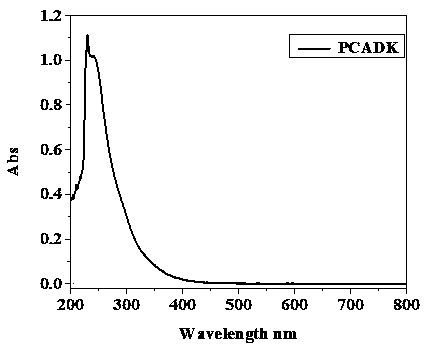Preparation method of PCADK composite microspheres encapsulating apoptotic genes
A technology of composite microspheres and genes, applied in the field of preparation of PCADK composite microspheres, can solve the problems of low gene transfection efficiency, difficulty in effectively overcoming various barriers of gene delivery, etc., so as to improve gene transfection efficiency and achieve controllable The effect of delivering, increasing the inhibition rate
- Summary
- Abstract
- Description
- Claims
- Application Information
AI Technical Summary
Problems solved by technology
Method used
Image
Examples
Embodiment 1
[0040] Preparation of BBC3@PCADK Composite Microspheres Encapsulating Apoptosis Gene
[0041] (1) Weigh 200 mg of PCADK and dissolve it in 2 mL of dichloromethane to obtain a PCADK dichloromethane solution, which is used as the oil phase for use; 20 μL of the plasmid solution containing the gene BBC3 is extracted as the inner water phase for use, wherein the plasmid concentration is 5 μg / μL Measure 60 mL, with a concentration of 1% PVA aqueous solution as the external water phase for subsequent use;
[0042] (2) Under the homogeneous condition of 13500 rpm / min, slowly drop 20 µL of the plasmid solution into the ice bath of the PCADK dichloromethane solution, and continue to stir for 2 min to obtain an emulsion;
[0043](3) The 1% PVA aqueous solution was continuously stirred at a speed of 1500 rpm / min, and then the emulsion obtained in step (2) was dropped into the above PVA aqueous solution, and the stirring was continued, and the dichloromethane was removed by volatilization...
Embodiment 2
[0046] Preparation of Bax@PCADK Composite Microspheres Encapsulating Apoptosis Gene
[0047] (1) Weigh 250 mg of PCADK and dissolve it in 3 mL of dichloromethane to obtain a PCADK dichloromethane solution, which is used as the oil phase for use; 25 μL of the plasmid solution containing the gene Bax is extracted as the inner aqueous phase for use, wherein the plasmid concentration is 5 μg / μL Measure 80 mL, with a concentration of 1% PVA aqueous solution as the external water phase for subsequent use;
[0048] (2) Under the homogeneous condition of 14500 rpm / min, slowly drop 25 µL of the plasmid solution into the ice bath of the PCADK dichloromethane solution, and continue to stir for 3 min to obtain an emulsion;
[0049] (3) The 1% PVA aqueous solution was continuously stirred at a rate of 2500 rpm / min, then the emulsion obtained in step (2) was dropped into the above-mentioned PVA aqueous solution, the stirring was continued, the dichloromethane was removed by volatilization, ...
Embodiment 3
[0051] Preparation of Noxa@PCADK Composite Microspheres Encapsulating Apoptosis Gene
[0052] (1) Weigh 100 mg of PCADK and dissolve it in 2 mL of dichloromethane to obtain a PCADK dichloromethane solution, which is used as the oil phase for use; 20 μL of the plasmid solution containing the gene Noxa is extracted as the inner water phase for use, wherein the plasmid concentration is 5 μg / μL Measure 60 mL, with a concentration of 1% PVA aqueous solution as the external water phase for subsequent use;
[0053] (2) Under the homogeneous condition of 13500 rpm / min, slowly drop 20 µL of the plasmid solution into the ice bath of the PCADK dichloromethane solution, and continue to stir for 2 min to obtain an emulsion;
[0054] (3) The 1% PVA aqueous solution was continuously stirred at a speed of 3000 rpm / min, and then the emulsion obtained in step (2) was dropped into the above PVA aqueous solution, and the stirring was continued, and the dichloromethane was removed by volatilizatio...
PUM
| Property | Measurement | Unit |
|---|---|---|
| radius | aaaaa | aaaaa |
Abstract
Description
Claims
Application Information
 Login to View More
Login to View More - R&D
- Intellectual Property
- Life Sciences
- Materials
- Tech Scout
- Unparalleled Data Quality
- Higher Quality Content
- 60% Fewer Hallucinations
Browse by: Latest US Patents, China's latest patents, Technical Efficacy Thesaurus, Application Domain, Technology Topic, Popular Technical Reports.
© 2025 PatSnap. All rights reserved.Legal|Privacy policy|Modern Slavery Act Transparency Statement|Sitemap|About US| Contact US: help@patsnap.com



